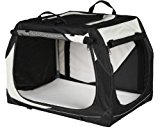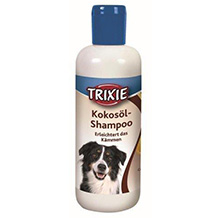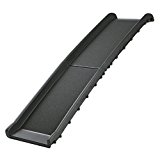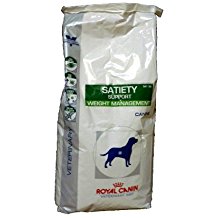Dog food purchasing advice: how to choose the right product
- What you need to know
- As with humans, a balanced diet is a prerequisite for a long and healthy life in dogs.
- Depending on its age, weight, and any allergies it may have, a dog needs different nutrients in different amounts.
- Which type of feeding is the right one depends mainly on the individual needs and preferences of dog owner and dog.
- More important than the type of food are its ingredients and their composition.
The right food for every dog
The dog is known as man’s best friend and is the most popular pet after the cat. In order for it to feel good and stay healthy and fit for as long as possible, the right dog food is necessary. Because not every food is equally suitable for every dog. The dog’s age, breed, activity level, allergies and weight all have an influence on which nutrients it needs and how much it can tolerate. And although dogs are often considered to be hoggish, there are also dogs that are very picky about their food and do not eat everything that their masters or mistresses put in their bowls. Dog owners have the big task of choosing the right food for their pet from the huge selection that the market now offers.
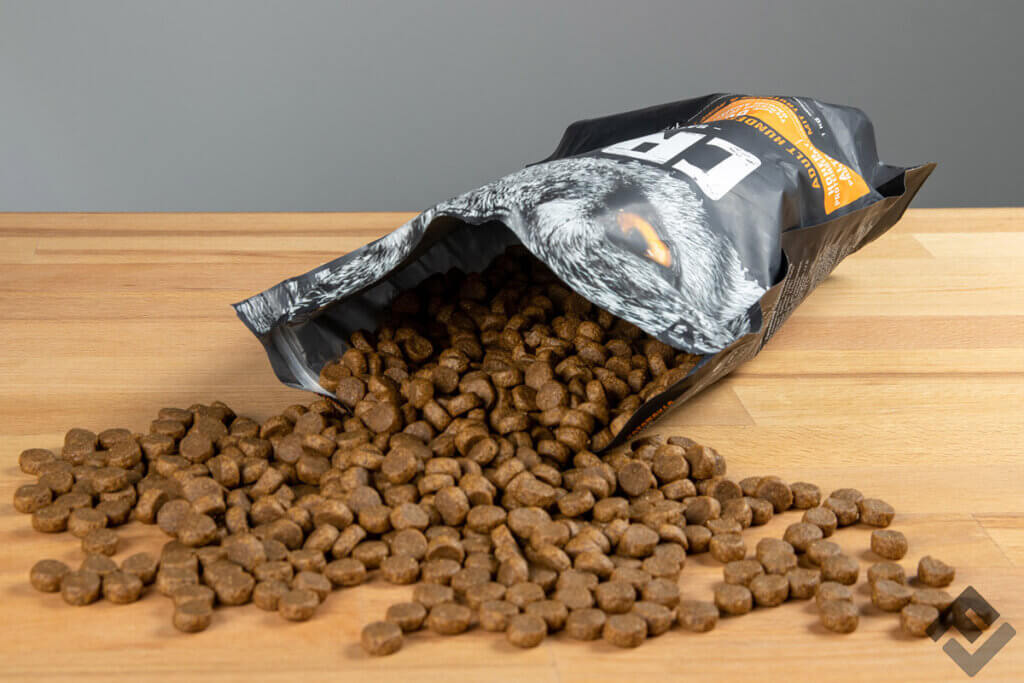
In our comparison of the best dog food, we present the most common types of food with their advantages and disadvantages. We also explain what you should pay special attention to when choosing food and what makes the most popular dog food brands. In our advice section, you can find out how much food to feed your dog and what to look out for when changing your dog’s food.
Which type of food is the right one?
As with cats, there are dry and wet foods for dogs. Both types of food have their advantages and disadvantages. There are also subcategories, such as organic dog food and grain-free dog food, which are available as both dry and wet food. Alternatively, owners choose the BARF diet for their dog. What BARF means and what distinguishes each type of food is explained below.
Dry food: convenient and long-lasting
Dry food is still very popular. It is characterised by its low water content of between three and twelve percent and is typically in the form of small pellets. Depending on how it is made, dry food can be divided into two categories: cold-pressed and extruded dry food. To produce cold-pressed dog food, the ingredients are first dried or ground and then mixed. They are then pressed into shape under great pressure. In contrast, in the extrusion process, the ingredients are crushed, mixed with water to form a paste and heated to 100 to 120 °C before being pressed. Due to the longer and more complex production process, cold-pressed dry food is usually more expensive than extruded.
Is cold-pressed or extruded dry food better?
There is no general answer to this question. It is true that the production of cold-pressed feed is gentler due to the lack of heating, which has the advantage that the vitamins naturally contained in the ingredients are usually preserved. However, the heat during extrusion causes a higher degree of breakdown of the ingredients. This means the dog can usually digest contained vegetables and grains better. In addition, extrusion makes the dry food last longer.
Regardless of how it is produced, dry food has the advantage over wet food that it has a longer shelf life due to the low water content. It is also easier to store because it does not need to be refrigerated. Thanks to its shape, it is easier to dose and not so messy. If a few pellets are spilled when filling the bowl or while eating, dog owners simply sweep them up. They clean the bowl just as easily by rinsing it regularly with water. Another advantage for dog owners: dry food causes less waste than wet food, as larger quantities can be packed in bags. Dry food is also less odorous than wet food.
Storage tip
Store dry food in an airtight receptacle so that it does not lose its aromas and crunchy texture.
Dry food is also more abundant than wet food. The pellets swell in the dog’s stomach, so the dog gets full from a smaller amount. This means that dry food is often cheaper.
However, the many advantages of dry food primarily affect the dog owner. Whereas its disadvantages mainly affect the dog. Dry food often has a low meat content. Instead, manufacturers often use a high proportion of grain as a cheap filler. Thus, dry food sometimes contains up to 60% carbohydrates, which is too much for a balanced and healthy diet. In return, the dog lacks water, which it would absorb with the food if it were fed wet. If you give your dog dry food, you must make sure that it takes in enough water, especially on hot days, so that it doesn’t become dehydrated. It should also be noted that the pressed pellets are more difficult to digest, and dry food with its many additives can more easily trigger intolerances and allergies. Nevertheless, you should not demonise dry food in general, as there are also many high-quality and healthy products available.
Advantages
- Long shelf life
- Easy to store
- Easy to dose
- More abundant
- Often cheaper than wet food or BARF
- Low odour
- Easier to clean
- Less packaging waste
Disadvantages
- Often low meat content
- Risk of dehydration
- Contains preservatives
- Difficult to digest
Wet food: fresh and juicy
Typical wet food is packed in tin cans. Unlike dry food, wet food has a liquid content of up to 60% and contains fewer calories. With it the dog takes in a large part of the liquid it needs directly with the food. In addition, the high water content has the advantage that dogs can swallow and digest wet food more easily than dry food. Furthermore, wet foods often contain more meat, which is more in line with a dog’s natural diet.
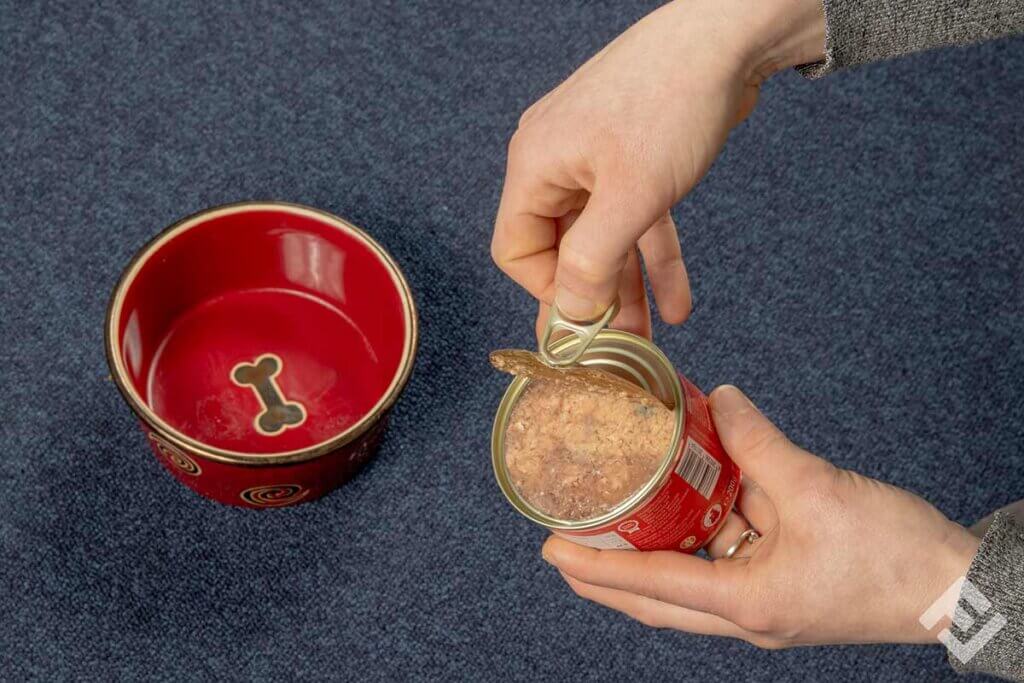
While the advantages of wet food mainly benefit the dog, its disadvantages mainly affect the owner. With its mushy or paste-like consistency, wet food is more difficult to dose and portion than the pellets of dry food. The high liquid content means that wet food has a much shorter shelf life than dry food. You should store an opened can in the refrigerator for a maximum of two to three days, tightly closed, for example in an airtight container. The food should not be left open in the bowl at room temperature for more than a few hours. Although small tins are often designed for exactly one or two meals, so that they are used up quickly, larger tins with more content, which cover the food requirement over several days, are usually cheaper. In addition, many dog owners are bothered by the often intense smell of wet food.
Storage tip
Unopened tin cans of wet food are best stored in a dry place in a cellar, pantry or cupboard. Do not expose the tins to direct sunlight.
Cheap wet food in particular often contains, like dry food, many additives such as cereals in addition to meat, which the dog cannot digest well and which, in the worst case, can lead to intolerances and allergies. In addition, many wet food manufacturers add sugar to make their food last longer. But this is just as unhealthy for dogs as it is for us humans. Purchasers of cheap dog food also often have to compromise on the quality of the meat. In some cases, the meat is low-quality offal. High-quality wet food with a high meat content and organic dog food are usually more expensive.
Advantages
- Covers a large proportion of the liquid requirement
- Easy to swallow
- Easy to digest
- Less calorie-dense
- Often higher meat content than many dry foods
Disadvantages
- Short shelf life
- More difficult to dose
- Higher cleaning effort
- Might contain a lot of sugar
- More odour intensive than dry food
Special dry and wet food
Both dry and wet food are available in special varieties. The most common of these and their special features are briefly presented below.
Organic dog food
Organic dog food is food that uses high-quality ingredients such as meat from species-appropriate farming. Organic dog food usually contains very few to no pesticides or genetically modified basic ingredients and additives. It is also produced, packaged and transported in a sustainable manner. Organic dog food is therefore not only better for the dog, but also for the environment. But what applies to food for us humans also applies to dog food: not all organic food is the same. There are different seals with different requirements for the ingredients contained. Compared to conventional dog food, organic dog food is usually significantly more expensive.
Grain-free dog food
Opinions differ on the question of whether dog food should contain grain. But one thing is clear: unlike cats, dogs can digest grain. It even provides healthy and valuable proteins, minerals and vitamins. However, more and more dogs suffer from intolerances or even allergies to cereals or the vegetable proteins they contain. If your dog is very susceptible to allergies or intolerances, or if it has already been diagnosed wit it or you suspect that your dog has a grain intolerance or allergy, it is recommended that you change its diet to grain-free food.
Dog food for different stages of life
Many manufacturers offer dog food designed for a specific stage of life.

Puppy food
Puppies normally feed on their mother’s milk until about four weeks of age. After that, they slowly start to eat solid food as well. Puppies are growing and therefore have special needs, such as higher energy requirements. Among other things, they need a lot of proteins, fat, various vitamins as well as phosphorus and calcium in a certain ratio to be able to form healthy bones and joints. Puppy food, also called junior food, is specially designed for their needs. Manufacturers usually recommend feeding it until the growth phase is complete.

Adult food
Depending on the breed, dogs are fully grown from the age of 10 to 12 months (small to medium-sized breeds such as Dachshunds or Beagles) or 20 months (large and very large breeds such as German Shepherds or St. Bernards). If they were to continue to eat puppy food, there would be a high risk of obesity, as adult dogs need much less energy than puppies. Therefore, good adult food contains less protein and fat and is lower in calories.

Senior food
The age at which dogs are considered seniors also depends on their breed. For very small dog breeds it is about nine years, for medium-sized breeds it is seven years and for giant breeds it is already five years. Special senior food is even lower in calories than adult food, because older dogs usually move less. In addition, kidney and liver function usually decline with age, the metabolism slows down and the performance of the dog’s fine nose decreases. Therefore, good senior food has a reduced protein and phosphorus content and an intense smell. As long as your dog is still very active at an older age and shows no signs of ageing, you should continue to feed it its normal adult food.
The age at which a dog reaches a new stage of life depends mainly on its size or weight and is breed-dependent. The following table provides a general guide to the age of a dog and the stage of life it is in. For puppies, the weight is not the current weight, but the weight they are expected to reach when fully grown.
| Weight (adult) | Age range puppy | Age range adult | Age range senior |
| Till 5 kg | Up to 8 months | 8 months to 10 years | 10 years and older |
| 5 to 10 kg | Up to 10 months | 10 months to 9 years | 9 years and older |
| 11 to 25 kg | Up to 12 months | 1 to 7 years | 7 years and older |
| 26 to 40 kg | Up to 15 months | 15 months to 6 years | 6 years and older |
| Up to 40 kg | Up to 20 months | 20 months to 5 years | 5 years and older |
BARF as an alternative to industrially produced food
Dry and wet food are industrially produced dog foods. An alternative to this is BARF, which stands for “Biologically Appropriate Raw Food”. BARF comes very close to the natural diet of the wolf from which the dog descended, which is why it is considered particularly species-appropriate among many dog owners. BARF is, however, very demanding and time-consuming for the dog owner. Contrary to what many people might think, raw meat is not the only thing that goes into a dog’s bowl. A balanced diet for the dog should consist of a maximum of 80% meat. In addition, it needs plant-based components such as fruit and vegetables.
Dog owners who want to try the BARF diet are best advised to work with an expert to create a diet plan that is precisely tailored to their dog’s needs. This way, they don’t run the risk of their dog lacking any nutrients or important vitamins or minerals, or getting too much of something. For dog owners who do not want to prepare their dog’s food themselves, but still want to use the BARF diet, some manufacturers offer ready-made frozen meals.
Advantages
- Particularly species-appropriate
- No artificial additives
- Very suitable for dogs with allergies
Disadvantages
- High effort
- Risk of incorrect feeding & deficiency symptoms
Vegetarian and vegan diets for dogs?
Feeding a dog a vegetarian or even vegan diet, i.e. without animal ingredients — is that even possible? And is it species-appropriate? The second question is debatable, because it would first of all be necessary to define what species-appropriate means in relation to the dog. But in principle it is possible to feed a dog an exclusively vegetarian or vegan diet and some manufacturers now have vegetarian or vegan dog food in their range. Because unlike cats, whose metabolism is geared towards meat, dogs, like us humans, are omnivores. It is only important that the food offered contains everything the dog’s body needs. Anyone who wants to feed their dog a vegetarian or vegan diet should therefore seek advice from an expert, for example a vet who specialises in this diet, and find out exactly what the various vegetarian and vegan feeds available on the market contain.

How to choose the right dog food
No matter whether dry or wet food and no matter which special form of it, there are always better and worse foods. More important than the type of dog food are its ingredients and their composition. Ideally, manufacturers should state these completely, correctly, clearly and comprehensibly on the packaging. Since a lot of information usually means a lot of unnecessary or even unhealthy additives, the list of ingredients should be as short as possible. Which ingredients a good dog food contains in which dosage is explained in more detail below.
What basic nutrients does a dog need?
The nutrients a dog needs for a healthy and balanced diet are divided into six categories:
- Proteins
- Fats
- Carbohydrates
- Water
- Minerals
- Vitamins
The dog gains energy from proteins, fats and carbohydrates, which its body needs for metabolic processes. As with humans, the same applies to dogs: more energy than necessary means weight gain, less means weight loss. Water is also important for metabolic processes and also serves as a solvent for vitamins and minerals, for example. Unlike the nutrients already mentioned, it is not possible to get enough water from food, so you should always provide your dog with fresh water in addition to food. With vitamins and minerals, the correct dosage is particularly important, as both a deficiency and an overdose are harmful to the dog’s health.
How well does the dog digest the food?
If your dog defecates very frequently or in large quantities, this often indicates that it is not digesting its food well. One reason for this could be intolerance to cereals, for example, and another could be poor quality dog food that contains many components that are difficult to digest.
Proteins, fats, carbohydrates, and meat content
The supply of sufficient high-quality protein is particularly important for a dog’s health. A lack of protein can lead to anaemia, emaciation and a brittle, dull coat. If the dog is still growing, too little protein can reduce the growth rate. However, the protein content must not be too high in the long term, as an over-supply of protein can cause kidney and liver damage in the long term. The proportion of crude protein should be between 20 and 26%.
Insects as an alternative source of protein
Dogs can develop allergies and intolerances not only to vegetable proteins, such as those found in cereals, but also to animal proteins. Insects are a rarely used protein but form an excellent basis for hypoallergenic food.
Due to their short intestines, dogs can usually absorb vegetable protein somewhat more poorly than animal protein. Therefore, dog foods with a high meat content are recommended. At least 25% meat should be included — ideally 70%. Still, it is not only the meat content that is important, but also the quality of the meat. The more high-quality lean meat it contains, the better. Offal such as lungs or kidneys should also be included, as they provide important nutrients such as vitamin B12 or iron. It’s better to stay away from food that contains animal by-products without any further information. This may be low-quality offal such as horns, hooves, fur and feathers, which are difficult for dogs to digest.
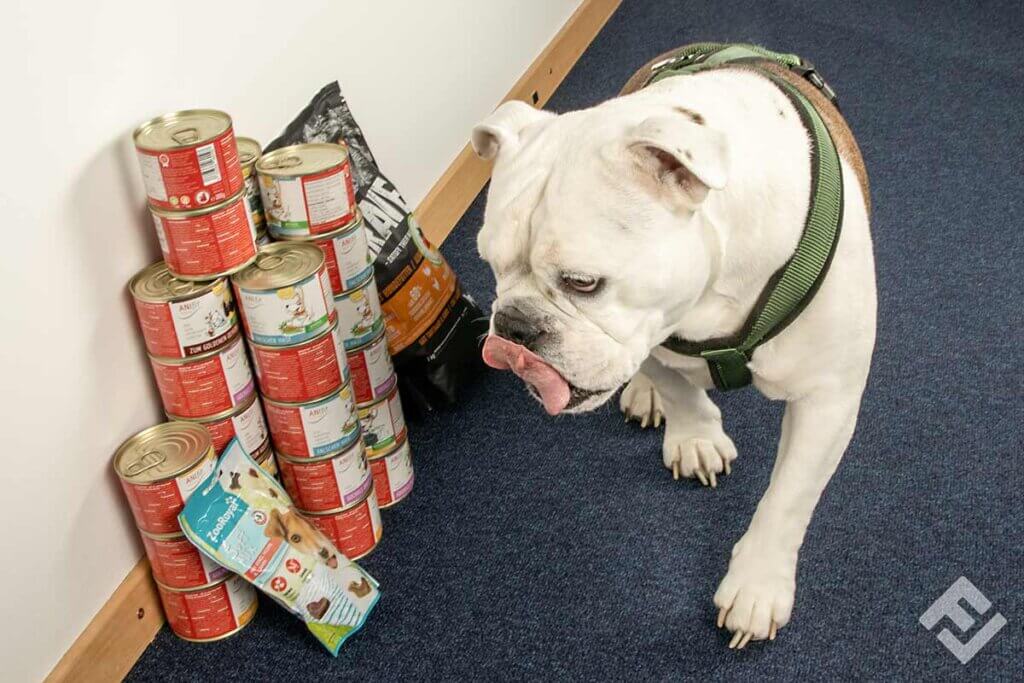
In addition to protein, dogs need fat as a source of energy for a functioning metabolism and for the absorption of fat-soluble vitamins such as vitamins A and K. A good dog food contains 6 to 17% crude fat. In addition to saturated fatty acids, which are mainly found in animal-based foods, it is important that the dog also consumes the essential fatty acids omega-3 and omega-6 in sufficient quantities. These are found, for example, in vegetable oils such as rapeseed oil or fatty sea fish such as salmon, mackerel or herring.
Carbohydrates, for example in the form of cereals, potatoes, fruit or vegetables, also serve as energy suppliers. For a healthy dog without allergies or intolerances, a combination of protein, fats and carbohydrates is optimal as an energy source. Though meat should always make up the largest portion of the food. As with our own diet, it is important for dogs to distinguish between “good” carbohydrates (polysaccharides or multiple sugars) and bad ones (monosaccharides or simple sugars and disaccharides or two-fold sugar) and to avoid the latter if possible. Multiple sugars are found, for example, in potatoes and wholemeal rice or wholemeal pasta.
What do crude ash and crude fiber mean?
The crude ash content indicates how many minerals the dog food contains. However, if the crude ash content is too high, this indicates that the food contains a lot of bones that are difficult to digest or proteins from feathers or horns. It should not exceed ten percent. Crude fiber is an indigestible plant component that regulates the consistency of faeces. A good feed contains 2 to 3.5% crude fiber.
Vitamins and minerals
Ideally, all vitamins and minerals necessary for the dog are contained in natural form in the ingredients of the dog food. However, in extruded dry dog food in particular, most of these are destroyed by the heat in the production process. Manufacturers solve this problem by adding the appropriate vitamins and minerals to their food in synthetic form. They list them on the food packaging under additives.
Which vitamins does the dog need?
You do not normally need to feed your dog vitamins C and K, as healthy dogs can synthesise these themselves. This is not the case with the following vitamins:

Vitamin B
They belong to the group of water-soluble vitamins and must be supplied regularly through food, as the body cannot store them well. B vitamins are involved in numerous metabolic processes in the body’s cells. For example, vitamin B1 plays a central role in carbohydrate and energy metabolism, and vitamin B12 is involved in blood formation and the building of nerve cells. A vitamin B deficiency can result in a lack of appetite and later in seizures and paralysis. Animal-based products, cereals, legumes and green vegetables, among others, have a high vitamin B content.
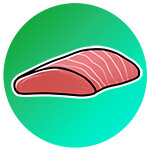
Vitamin D
Unlike us humans, dogs cannot synthesise vitamin D themselves under sunlight, so they depend on sufficient vitamin D in their diet. Dogs need vitamin D for bone formation and to utilise calcium and phosphorus. A deficiency can lead to osteoporosis. However, caution is also needed here against overdosing. Too much vitamin D can cause calcification of the blood vessels in the long term. Vitamin D is found in fish and liver, for example.

Vitamin E
Like vitamin D, vitamin E is fat-soluble. It plays an important role in protecting the cell membranes. A vitamin E deficiency in dogs manifests itself in various symptoms such as growth or muscle damage. During pregnancy and growth, dogs have an increased vitamin E requirement. Dogs have a high tolerance for vitamin E overdoses. So far, scientists have not found any negative consequences of vitamin E overdose. Vitamin E sources include nuts, oils and cereal germ.

Vitamin A
Vitamin A is also fat-soluble. Animals can normally produce it in their intestines from carotenoids. Vitamin A is important for the eyes and reproduction. A lack of it in adult dogs leads to infertility, corneal opacities and conjunctivitis, among other things, in the long term. Dogs tend to be tolerant of too much vitamin A. Yet a permanent overdose can lead to loss of appetite, joint pain and a breakdown of bone substance. While vitamin A is found exclusively in animal-based foods such as liver, milk and eggs, carotenoids such as beta-carotene are found in plant foods such as carrots, sweet potatoes and spinach.
What minerals does a good dog food provide?
Minerals can be divided into two groups: bulk elements and trace elements. The bulk elements that a dog needs include:
| Bulk elements | Abbreviation | Functions | Sources |
| Calcium | Ca | Bone and tooth formation, blood clotting, nerve and heart function | Bones, eggshells |
| Phosphorus | Ph | Growth, bone and tooth formation | Meat, dairy products, eggs |
| Potassium | K | Heart function, muscle contraction | Milk, meat, fruit |
| Sodium | Na | Acid-base homeostasis, growth promotion | Fish, salt, cereals |
| Magnesium | Mg | Energy production, protein synthesis | Bones, cereals |
| Chloride | Cl | Stomach acid formation | Fish, salt, cereals |
The dosage in which dogs need the various bulk elements depends, among other things, on their age, breed and state of health. For example, a balanced supply of calcium and phosphorus is very important for puppies to develop a healthy skeleton.
Trace elements are only needed in very small amounts, yet they play an important role as they are involved in many metabolic functions. The most important trace elements for dogs include iron, iodine, copper, selenium and zinc. They are mainly found in animal products. A good dog food should never have too high a content of trace elements, as many of them can have a toxic effect in high levels.
Tips on feeding
In our advice section, we answer some of the most important questions about feeding a dog the right food. Among other things, we explain how to determine the right amount of food for your dog and how to recognise food intolerances and allergies.
How much food does my dog need?
How much food a dog needs depends mainly on its age, weight and activity level, in addition to the energy content of the food. Moreover, of course, you need to subtract supplementary feeds such as treats from the main meals to avoid your dog gaining too much weight.
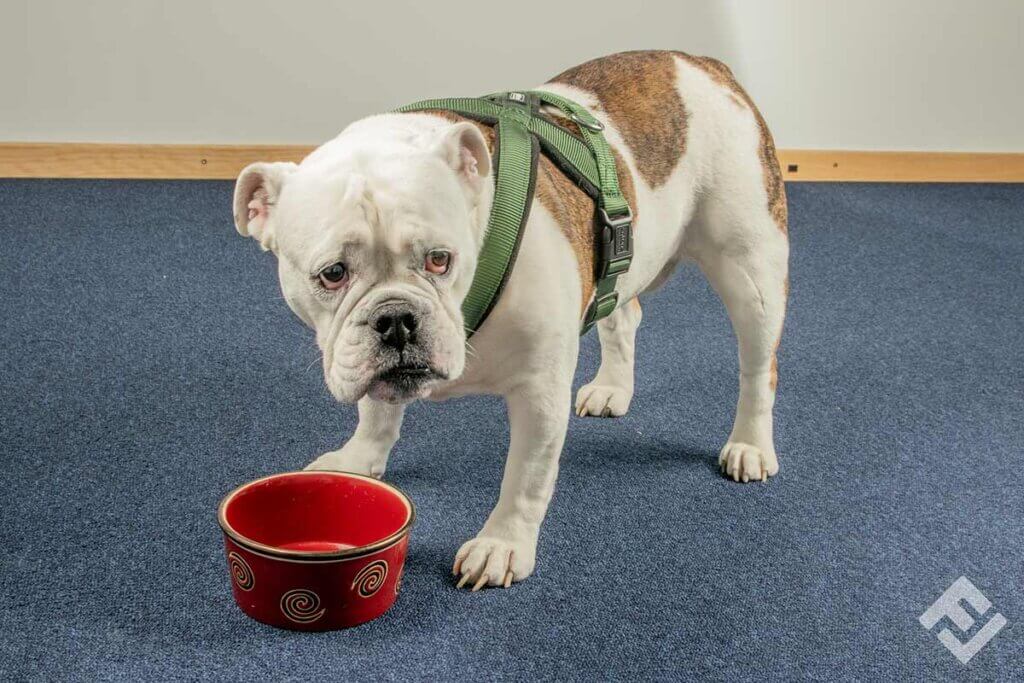
For an adult, averagely active dog, experts recommend feeding between two and four percent of its body weight daily as a rough guide. The dog needs about twice as much wet food as dry food because of the water content. For a medium-sized dog weighing 15 kilograms, this would be 300 grams of dry food and 600 grams of wet food. Puppies are growing and need more food accordingly. Here you do not use the current weight as a basis, but the weight that the puppy is expected to reach when fully grown. For older dogs, you will need to adjust the amount of food to the often decreasing activity level and reduce it accordingly to avoid weight gain.
Measuring the amount of food
The easiest way to measure the amount of food you need is to use a normal kitchen scale. If you don’t have a scale at hand, you can use special measuring cups, for example, which many dog food manufacturers usually offer as a free gift with their products.
How should I feed my dog?
Most adult dogs do well with one to two portions of food a day. Puppies, on the other hand, cannot eat large amounts of food due to their small stomachs and need several smaller portions a day. Up to the age of four months, experts recommend dividing the puppy’s daily food ration into four small meals. From the age of four months you can reduce the feeding frequency to three times a day, from the age of about half a year to twice a day and from one year on to once a day if necessary.
Important: rest after the meal
After the main meals, your dog should rest for about an hour and neither go for a walk nor play. Especially with large dogs, there is otherwise a high risk of a painful and dangerous twisted stomach.
How do I recognise a food allergy?
Intolerance reactions or food allergies do not only occur shortly after a change of food, but also and especially when a dog has been eating a food for a long time. The following signs and behaviours of your dog may indicate a food intolerance or allergy:
- Frequent scratching, especially in the area of the head and ears
- Swollen eyes
- Irritated or inflamed skin
- Diarrhoea
- Vomiting
Naturally, these symptoms do not necessarily have to be related to the dog’s diet, but can just as easily be a side effect of various illnesses. Therefore, before experimenting with the food, you should consult a vet and ask for advice. If the vet suspects a food intolerance or even an allergy, he or she will normally work with you to put together a plan for an elimination diet to find the allergen and avoid it in the future.
What do I have to bear in mind when changing the food?
If you find that your dog has an intolerance or allergy to any of the ingredients in its current food, you will need to look for a new food. You also need to change the food when your dog enters a new phase of life, for example when it comes out of puppyhood. The most important thing when changing food is to do it slowly and carefully. An abrupt change of food can lead to the dog refusing the food. Also, a sudden change of food often results in diarrhoea or vomiting, as the dog’s digestive tract is used to the old meals. In order not to overtax the animal, it is recommended to mix the new dog food slowly with the old one and to increase the proportion of the new food gradually over a period of about ten days. With a sensitive dog, the acclimatisation phase should take even longer. Even if you do everything right and the dog tolerates the new food well, there may be changes in faecal structures or the frequency of defecation during the transition phase.
Popular dog food brands
Numerous manufacturers advertise dog food in a wide variety of flavours to win the favour of masters and mistresses. To help you find your way around, here are some of the most popular dog food brands and their characteristics.
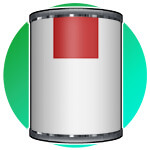
RINTI
The RINTI brand belongs to the family business FINNERN Petfood family. The range mainly includes wet food in tins and bowls as well as snacks. In addition, RINTI now offers the dry food RINTI MAX-I-MUM in four different varieties, which consists of 70% lean meat and offal. RINTI also advertises a balanced protein-fat ratio for gentle digestion. At about four pounds per kilogram of dry food, RINTI MAX-I-MUM is one of the higher-priced dry foods.
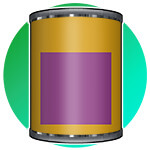
JOSERA
According to its own statement, the family-owned company JOSERA stands for healthy pet food, sustainable and cost-conscious actions and a practised quality management. JOSERA checks the quality of its feed in its own laboratory. Artificial colourings, flavourings and preservatives as well as wheat, soya, sugar and dairy products are generally not used. The JOSERA range includes dog, cat and horse food. The range for dogs focuses on junior, adult and senior dry food for small, medium and large dogs. Compared to other brands, JOSERA is rather inexpensive with prices starting at three pounds for a kilogram of dry food.
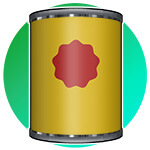
Pedigree
The Pedigree brand is probably familiar to many consumers from TV commercials. In addition, the brand’s food and snacks can be found in most common supermarkets. Unlike most other brands, Pedigree focuses exclusively on dogs. The range includes dry and wet food for puppies as well as for adult and older dogs. The manufacturer also offers treats and special dental care snacks. At just under 2 pounds for a kilogram of dry food, Pedigree is in the low to medium price range. Not in their range are special products for dogs with allergies or grain-free food.

ROYAL CANIN
Since its foundation in 1968, the manufacturer ROYAL CANIN has been working with veterinarians and breeders to research the needs of different breeds of dogs and cats and to develop special nutritional solutions for them. For example, ROYAL CANIN offers special dry dog food for Chihuahuas, Dachshunds, French Bulldogs and Yorkshire Terriers. The range also includes dry food for allergic and sterilised dogs. The comparatively expensive food (from 4 pounds per kilogram of dry food) is available from selected specialist retailers such as Zooplus or from many vets.
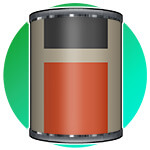
Animonda
According to its own statement, the young company animonda is aimed at pet owners who place high demands on the food for their four-legged friends. The range includes food for dogs and cats. The range for dogs is divided into four different brands. One of them is aimed at owners of overweight dogs, another is for small dogs and another is for nutritionally sensitive dogs. At animonda you will find mainly wet food in a can or bowl, but also a few dry foods. The cheapest dry food is in the middle range costs around 2 pounds per kilogram.
Images 1–17: © FinalCheck


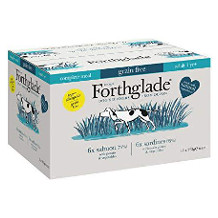












 1,810 reviews
1,810 reviews
